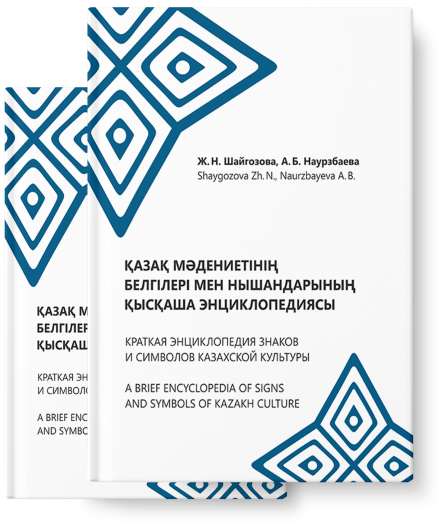
A short encyclopedia of
Signs and symbols of
Kazakh culture

The ornamental system of many nations of the world is permeated by solar symbolism, which has a universal form and is defined mainly by the following figures: circle, rhombus, square, hexagon, octahedron, swastika, various crosses, 6-, 8-rayed and floral rosettes, and images of paired curls.
In general, the solar circle reflects the relics of sun worship and is closely related to the cult of fire (fire is an earthly equivalent of the sun), Nauryz and the ancient Turkic goddess Umay (Ot Ana). Fire as a purifying substance is a part of many rites and rituals among Turkic peoples (otkа mai kuyu – wedding ceremony of Kazakhs; alastau – purification of home, cattle by fire and many others).
In sacred geometry the circle is considered a symbol of infinity and perfection, and among the Kazakhs the solar circle means eternal life, longevity and infinity. In ancient times, the sun circle had a magical meaning for many Eurasian nomads and was considered an amulet, a talisman of good luck, and was usually associated with a male image or a horse.
In ancient times, circular movements were also considered magical and reflected in the ritual culture of the Kazakhs: ainalu – circular movements in shamanic practice, dance culture (round dance, closed processions), practice of worshipping sacred sites – circling three or more times and others. The circle, in conjunction with other graphic elements, forms a widely ramified field of symbolic and emblematic associations.
Kazakhs often used the sun circle as a compositional center on pile and felt carpets, on clothing (especially on wedding garments embroidered with chapan for men and women) in combination with plant or zoomorphic motifs symbolizing grace and happy life.
Different variants of the sun circle are swirling rosettes, which are widely used on handicraft items of Kazakhs and other Turkic peoples: Furniture decor, clothing, textiles, ceramics, etc., which is connected with the semantics of the sun sign and embodies the canonical motif of the archaic sun cult.
The actual form of the nomadic residential yurt is a circle, in which one of its elements – the shanyraq – is a sacred object for the Turkic peoples since ancient times, embodying the concept of space and symbolizing the unity of the family.

